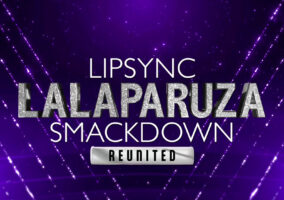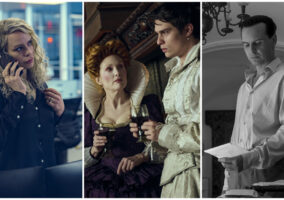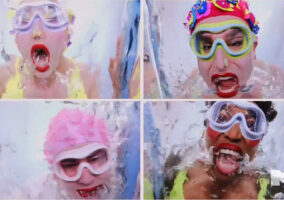…And we’re back.
And boy, are we ever happy and excited to be back here. Before we get started, we’d like to be a little self-serving and obnoxious.
When we first came up with the idea of Mad Style and wrote the first couple of entries, Tom said to Lorenzo, “I’m not sure why, but this feature is going to become the most popular feature on our site.” And it did. We say this not to pat ourselves on the back (no, really) but to say “Welcome,” to the scores of people coming back to us or coming here for the first time because someone recommended this feature to them.
The second thing we want to say has to do with the… well, we guess we’d call it the “point” to this whole obsessive endeavor. Mad Men is one of the most analyzed shows on television and probably, when all is said and done, one of the most analyzed in the history of television. The downside to that can be an awful lot of over-analyzing. And we admit we’re as guilty of it as anyone. But the point to this kind of reading of the show is to deepen the understanding of it; to open up the conversation and demonstrate that there’s more to a filmed narrative than just the text or the acting. It’s not to crack open a code and find a hidden meaning inside like a prize in a Cracker Jack box. There are multiple layers and multiple meanings in any text of any depth. The best anyone can do when analyzing it is to understand that and accept that they’re bringing their own interpretation to it. There are times when we can fairly definitively say what the intent of the costume designer, Janie Bryant was, but it’s more important in this kind of analysis to sometimes separate the intentions of the artist from the work itself and see what the work is saying independent of them.
Now let’s dive in.

There was a lot of interaction between hot and cold imagery in this episode; and on film, one of the best ways to convey heat is through intense color. Alternately, cold tends to be conveyed through washed out, gray-toned colors, as we’ll see later.
Anyway, the Hawaii scenes were awash in color and it served a bunch of purposes. First, it’s Hawaii, so the colors place you in the setting; second, it’s hot and like we said, intense color serves to convey heat onscreen. Third, and most important of all, we’re on the cusp of 1968, in the wake of the Summer of Love; a time when design, but particularly fashion design, exploded all over the masses in a way it hasn’t done before or since. We want you to, as you go through these posts, keep in your mind’s eye the iconic look of the show, back when Don and Betty were married, Pete and Peggy were flirting, and the offices of Sterling Cooper were a monument to mid-Century design. Think of all those pale, washed out colors, grey flannel suits, delicate, neutral plaids. Think of the glamorous client dinners and award dinners that Betty and Don used to get dressed up for. Hold on to that image of glamour and restraint that typified late ’50s style, because from here on out, everything is wildly – and we do mean wildly – different for everyone.
Everyone except Don, of course.


This is all very typical resort clothing of the period; very much of its time and place. It’s of some interest to us that Megan is consistently dressed in purple throughout these scenes. Megan’s wild prints define her as much as Joan’s pencil skirts or Peggy’s schoolgirl outfits. It signals her youth and trendiness, as well as her somewhat carefree personality. At times, it’s used to refer to her other-ness, as someone who is not an American.

This woman represents a perfect example of what we think Janie’s thesis for this season will be. It’s about the way these wilder styles trickled down to the less fashionable in such a short period of time. That woman’s suit couldn’t be more traditional or conservative, but her beehive is getting ever larger and closer to Jesus as the ’60s go on. Which isn’t to suggest that this is a trendy or even new look. Bouffants and beehives have been around for years at this point. But they really reached their zenith, both figuratively and literally, by the late ’60s, when even elderly women were wearing their hair big and bold, and the heights reached ridiculous proportions.

Again, perfectly normal and representative resort wear. So much so, that you could dress like this now. You can’t differentiate characters too much when they’re all walking around in Hawaiian prints but Don’s respectable middle-aged man’s summer blazer effectively draws a sharp generational line between him and the young soldier.


More purples for Megan. We’re only including the wedding pictures because we figure dozens of people are going to comment that their mom/sister/aunt or they themselves wore a similar dress for her wedding. It’s very much of that post- “Priscilla & Elvis wedding” period, with the big hair worn down in the front and the veil worn back on the head over a relatively simple dress.

Mirror freaking images of each other. Or perhaps negative images would be more accurate. Two over-pampered, over-furred, over-lipstick-d unhappy women. It’s amazing how costuming can take two people who absolutely look nothing like each other and make you see how much they’re alike.

That living room shot could be from a TV Christmas special of the period. Betty is still – and probably forevermore – dressing in that conservative, mature Republican political wife drag, right down to the bow on the front of her suit. She is, after all, a package to be presented to the world. Sandy, the girl she looked at as a younger version of herself, is dressed in a very Betty pink with a similar bow across the front of her waist, tying the two together across the scene. It’s notable how much Sally stands apart. Betty and Mama Francis are tied together; Betty and Sandy are tied together; but Sally, in her brilliant blue dress and simple hair (the simplest female hair in the scene, if not the entire show, signaling the adoption of more relaxed hairstyles for young girls in the post-hippy period), she’s a bolt of sarcasm cutting the room in half.
There’s almost no point in looking at the males in this scene because it was all about the women. Henry is traditional and conservative, as always.
Look at the little toilet paper roll angels next to Betty. Cute.

This was a great little bit where the costuming took over the storytelling. It was a bit confusing the first time around, but once you realize Megan’s wearing two wildly different outfits, you get that we’ve crash cut to a flashback and then back to the present day.
More use of furs here, both on Megan and on Sylvia. Sylvia’s style is clearly mature – in a lot of ways, too mature – and highly traditional. Her Catholicism is referenced frequently and you can see the prominent gold cross against her stark black dress, nun-like. She’s a foreboding figure in the scene; especially in relation to the bright, sunny, wild Megan, whose reaction borders on histrionic, as opposed to Sylvia, who is composed, concerned, and making the sign of the cross.

There was much discussion – as there would be – about Betty’s shocking rape joke. This is an instance where we don’t think over-analyzing it serves much purpose. It’s fairly straightforward, as all of Betty’s emotional responses are. She has always liked to rebel against the restrictions of her life by occasionally being shocking in some way. This is a woman who shot the neighbor’s pigeons, picked up a guy in a bar during the Cuban Missile Crisis and fucked him in a back room, manipulated a good friend into adultery because she didn’t have the nerve to do it at the time, and dressed up like an Italian prostitute in a neo-realist film and flirted with a bunch of Roman lotharios. She likes to be bad, and Don helped fulfill that side of her. Henry; solid, traditional, unflappable Henry, just doesn’t turn her crank that way. So in order to get a rise out of him (so to speak), she went to the blackest kind of humor she could dredge up. You have to remember how differently people saw rape at the time. It was under-reported and under-prosecuted to a sickening degree, and most of the population thought on some level that it was simply about sex that got a little out of hand.
It’s not a coincidence that her joke involved raping a young girl she sees as a stand-in for herself. It’s also not a coincidence that she’s dressed in the same pink that girl wore in the previous scene, with a similar bow prominently placed on the front. It’s feminine (to a coquettish level) and youthful and it’s meant to be jarring in the context of the scene.

Meanwhile, over at the Draper household, Megan is in a buzzing, angry print that signifies her mood in this scene.

Back again to Betty, drawing those parallels in pink. We groaned when we saw Betty’s bathrobe, as we suspect anyone who lived back then would. It seemed every house had at least one version of this robe appearing in milions of Christmas morning home movies. Scratchy, stiff and highly synthetic in most cases, it was an awful look that made even slim women look like mattresses.

It’s only lightly signaled in this episode – and barely signaled at all here – but Abe and Peggy are clearly worlds apart. He’s obviously getting more entrenched in the counterculture and liberal causes and it is, of course, all over his clothing. Peggy, on the other hand, is the stylish, go-getting New York career girl of the period, with her knee-socks and beret. We may look at this outfit and see Velma from Scooby Doo, but this really was NYC-stylish in a “Marlo Thomas in That Girl” kind of way.
Peggy wears a lot of blues and greens in this episode, possibly signaling a new set of power colors to replace her old, mid-Century, mustard yellow power color. The blue-and-green color combo was extremely popular during this colorful period, as was the pink-and-orange one. They come back in and out of style, but they’re fairly strongly identified with the late sixties. As was purple, for that matter, which we’re already seeing a lot of.

Blue and green. Power and money. Her coat and her suit have masculine touches and she’s wearing a plaid scarf slung around her neck, exactly the way Don does.

She also serves as a perfect balance between the two men in the room; one in blue, one in green.
Cutler, Gleason and Chaough is clearly not the modern, cutting edge agency SCDP is trying to present itself as. In fact, the late ’50s-style design we see glimpses of makes it look almost exactly like the old SC offices. No surprise there, as Ted Chaough clearly likes to poach talent from Don’s agency.

Go-getting youngster Bob Benson could have walked out of an ad of the period himself, so perfectly does he capture that sixties post-college, career man style. He is yet another version of a younger Don coming into the story. Don himself looked at one time like he could have walked out of an advertisement, but not so much anymore. Bob’s suit and tie are cut slim, but not as slim as a few years before. It’s a more relaxed, preppier style of suit with way more touches of color to it than Don’s.
Then again, as we’ll see, business wear shifted radically in a very short time.

To be fair, this is not indicative of most offices in 1967. SCDP, like a lot of agencies of the period, had a more cutting-edge vibe to it than, say, working for an insurance company or law firm. The pot-smoking out in the open in the office was a bit much, as we don’t believe SCDP would be quite that open-minded about it, but it wasn’t unheard-of for the period. Again, we’re looking at a representation of just how much things have changed and just how rapidly it occured. We are, after all, still in the same year we were when we ended last season. But in less than a year, many people look drastically different. Ginsberg is running headlong into the counterculture styles of the late ’60s, even as he works to sell Dow chemical to the masses. Stan is as Stan always was, except with a much more epic beard.
New office gal almost serves as a Peggy stand-in, with her blue, schoolgirl plaid. She’s clearly no Peggy, though, and we think the almost-but-not-quite style similarity is meant to highlight that.

Dawn’s making good money. Her wardrobe looks more expensive all of a sudden, with more flourishes to it. She’s obviously much more comfortable in the office and isn’t giving off that “must be a credit to my race” vibe of last season.

Bam. There’s your 1960s. Women’s styles have been getting bolder and louder for a little while, but it was 1968 when men’s styles really exploded and, like we keep saying, spread out over multiple demographics. Even Roger, who is the oldest man in this scene, is wearing new, brighter styles; a royal blue double-breasted jacket with brass buttons (speaking to his wealth). Pete, on the other hand, is digging in his heels and becoming even more establishment, adding Roger’s old vest to his suit to give him an appearance of experience and authority. Harry is, of course, off on his own; inspired by the wilder California styles for a while now, he’s got the freedom to fly his color and pattern flag proudly. Five years ago, he looked like this. And that kind of rapid change in style – for someone who isn’t part of the youth generation and isn’t considered all that trendy – was very normal for the period.
Don is unchanged, of course. Inflexible and having a harder and harder time of it as the world around him changes.

Joan didn’t get much to do this episode but Janie Bryant clearly wanted to make sure she made an impression. This bright purple suit with ruffles on the collar and cuffs, calls back to the more Edwardian styles of the younger set, from the Stones to Hendrix. Which isn’t to suggest Joanie’s heading to Monterey any time soon; just that the styles of the younger generation trickled up. It also manages to mimic menswear – something new for Joan that started when she became partner.
Purple used to signal heartbreak for Joan, but that’s clearly not the case anymore.

Caroline – who never, ever fails to make us laugh – serves as a reminder that for plenty of people, the newer styles could stay on the racks, thank you very much.

Meanwhile, Peggy is still working a Catholic schoolgirl look, but one that manages to be far more stylish and grownup than her previous attempts. This worked perfectly for this scene because she was referencing her Catholicness all over the dialogue (that grumpy, rote “And also with you,” was hilarious). We’ll see this outfit again in a much later scene, where it will serve a slightly different purpose.

And finally (for now), one final representation of the clash between old and new; traditional and bold – and how it’s encroached on every corner of society. We’ve seen young ladies in styles like this on the show, but mostly in the background. Having her all over the office like this – and actually working, not attending a party in the background – is a visual lightning bolt. She’s new, she’s bold, she’s like nothing else in that office, and most important of all, you can’t take your eyes off her. The tumult of the late ’60s has arrived, and it’s standing in Don Draper’s office, literally wiping the sweat from his brow.
Part 2 is here and our initial non-costume-related review of this episode is here.
[Stills: tomandlorenzo.com]
Mad Men: The Doorway Next Post:
Mad Style: The Doorway, Part 2
Please review our Community Guidelines before posting a comment. Thank you!



